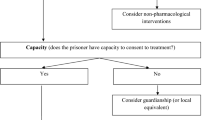Abstract
Violence significantly affects people in prison. While aggression may be exacerbated by environmental factors, violence may be reduced by early recognition of agitation, de-escalation techniques and non-pharmacological, behaviourally-based therapy. Pharmacological options may be required in rapid sedation protocols for highly agitated prisoners, but are also required to treat underlying serious illnesses such as schizophrenia, bipolar disorder and major depressive disorder. Pharmacological options may also help people with poor impulse control, but are not first-line options for personality disorders. Overall, the ideal management of aggression is to treat the underlying cause through pharmacological and non-pharmacological means.

Similar content being viewed by others
References
Weightman M, Kini R, Parker R, et al. Pharmacological approaches to managing violence and aggression in prison populations: clinical and ethical issues. Drugs. 2020;80(16):1635–47.
Comai S, Tau M, Gobbi G. The psychopharmacology of aggressive behavior: a translational approach: part 1. Neurobiology. J Clin Psychopharmacol. 2012;32(1):83–94.
Comai S, Tau M, Pavlovic Z, et al. The psychopharmacology of aggressive behavior: a translational approach: part 2. Clinical studies using atypical antipsychotics, anticonvulsants, and lithium. J Clin Psychopharmacol. 2012;32(2):237–60.
Stahl SM, Morrissette DA, Cummings M, et al. California state hospital violence assessment and treatment (Cal-VAT) guidelines. CNS Spectr. 2014;19(5):449–65.
Fazel S, Seewald K. Severe mental illness in 33,588 prisoners worldwide: systematic review and meta-regression analysis. Br J Psychiatry. 2012;200(5):364–73.
Galletly C, Castle D, Dark F, et al. Royal Australian and New Zealand College of Psychiatrists clinical practice guidelines for the management of schizophrenia and related disorders. Aust NZ J Psychiatry. 2016;50(5):1–117.
Fazel S, Danesh J. Serious mental disorder in 23,000 prisoners: a systematic review of 62 surveys. Lancet. 2002;359(9306):545–50.
Fazel S, Gulati G, Linsell L, et al. Schizophrenia and violence: systematic review and meta-analysis. PLoS Med. 2009;6(8):e1000120.
National Institute for Health and Care Excellence. Violence and aggression: short-term management in mental health, health and community settings. 2015. https://www.nice.org.uk/. Accessed 16 Apr 2021.
Kamath J, Temporini HD, Quarti S, et al. Psychiatric use and utility of divalproex sodium in Connecticut prisons. Int J Offender Ther Comp Criminol. 2008;52(3):358–70.
Siegel A, Bhatt S, Bhatt R, et al. The neurobiological bases for development of pharmacological treatments of aggressive disorders. Curr Neuropharmacol. 2007;5(2):135–47.
Barratt ES, Kent TA, Bryant SG, et al. A controlled trial of phenytoin in impulsive aggression. J Clin Psychopharmacol. 1991;11(6):388–9.
Barratt ES, Stanford MS, Felthous AR, et al. The effects of phenytoin on impulsive and premeditated aggression: a controlled study. J Clin Psychopharmacol. 1997;17(5):341–9.
Gobbi G, Gaudreau PO, Leblanc N. Efficacy of topiramate, valproate, and their combination on aggression/agitation behavior in patients with psychosis. J Clin Psychopharmacol. 2006;26(5):467–73.
Sheard MH, Marini JL, Bridges CI, et al. The effect of lithium on impulsive aggressive behavior in man. Am J Psychiatry. 1976;133(12):1409–13.
Sharma T, Guski LS, Freund N, et al. Suicidality and aggression during antidepressant treatment: systematic review and meta-analyses based on clinical study reports. BMJ. 2016;352:i65.
Lagerberg T, Fazel S, Molero Y, et al. Associations between selective serotonin reuptake inhibitors and violent crime in adolescents, young, and older adults—a Swedish register-based study. Eur Neuropsychopharmacol. 2020;36:1–9.
Duramed Pharmaceuticals. Naltrexone hydrochloride tablets USP (Revia); US prescribing information. 2013. https://dailymed.nlm.nih.gov/. Accessed 16 Apr 2021.
Forest Pharmaceuticals Inc. Acamprosate calcium (Campral) delayed-release tablets; US prescribing information. 2005. https://dailymed.nlm.nih.gov/. Accessed 16 Apr 2021.
Stöver H, Michels II. Drug use and opioid substitution treatment for prisoners. Harm Reduct J. 2010;7:17.
Pilkinton PD, Pilkinton JC. Prescribing in prison: minimizing psychotropic drug diversion in correctional practice. J Correct Health Care. 2014;20(2):95–104.
Appelbaum KL. Attention deficit hyperactivity disorder in prison: a treatment protocol. J Am Acad Psychiatry Law. 2009;37(1):45–9.
Author information
Authors and Affiliations
Corresponding author
Ethics declarations
Funding
The preparation of this review was not supported by any external funding.
Authorship and conflict of interest
C. Fenton, a contracted employee of Adis International Ltd/Springer Nature, and A. Lee, a salaried employee of Adis International Ltd/Springer Nature, declare no relevant conflicts of interest. All authors contributed to the review and are responsible for the article content.
Ethics approval, Consent to participate, Consent for publication, Availability of data and material, Code availability
Not applicable.
Rights and permissions
About this article
Cite this article
Fenton, C., Lee, A. Pre-empt aggression in prison and treat precipitating conditions. Drugs Ther Perspect 37, 242–248 (2021). https://doi.org/10.1007/s40267-021-00836-z
Accepted:
Published:
Issue Date:
DOI: https://doi.org/10.1007/s40267-021-00836-z



